

Lincoln
This is a city, beautiful for situation. One can see it for miles nestled down between the hills among its beautiful trees, with the town pot the only natural curio in the vicinity, towering like a big black watch-tower that guards from harm.
The streets of this city are not paved with gold owing to the fact that there is but one man in town who can fit crutches to lame eyes, but they are lined up and down with delightful shade trees.
Lincoln has city waterworks, electric lights, excellent public schools, a college, fine residences, two blocks of flourishing business houses, a sanitarium, and a lot of automobiles. It is in the center of a large and prosperous farming territory, without a rival for many miles on either side, and the largest town on this branch of the Union Pacific between Salina and the State line. Nearly all the business houses in Lincoln are built of native rock, and except for the few frame structures brought over from Abram, they have always been.
We get the early beginnings of Lincoln in the county seat fight, so it is not necessary to dwell on it here. The town was plotted May 9, 1971, and included the northwest quarter section 6, town 12, range 7. The town company were W.L. Gillmore, D.W. Henderson, J.S. Strange, Washington Smith, Thomas Boyle, S.M. Babellette, and James Askey.
Judge Prescott ordered a city election which resulted as follows: Mayor, Geo. M. Lutes; police judge, Mortimer Gragg; clerk, Lon A. Minx; councilmen, D.E. Coolbaugh, Geo. Green, Luther Stewart, H. Holcomb, Joe. E. Cheney.
September 23, 1879, Lincoln became a city of the third class. So much of the history of Lincoln Center has been given under special articles that there is not much left to say here. Being the county seat it was the scene of many remarkable and exciting incidents during the days when it was customary to make strenuous remarks and punctuate them with bullets. Some of these incidents might prove interesting if told.
But there is another side to the picture and another spirit which stood in sharp contrast to lawlessness. Lincoln from the very first was a hot-bed of progress and reform. Never was liquor legally sold in the town except in the year 1879. The State-wide suffrage campaign which had lain dormant after the defeat of 1876 was renewed by Lincoln women. Some of the most earnest and successful exponents of new reformatory measures, in politics, religion, and social life, have been Lincoln people.
It is evident from the outcome, most people were of the right, sort, so it is hardly worth while to elaborate on the sneak-thief, cowardly acts of a few adventurers when there was real work being done.
There is a list of the business people in Lincoln in 1879 which we wish to mention in passing; H. Holcomb and E.B. Bishop, hardware; C.W. Perkins, grocer; Mr. Z. Burton, drugs; Frank Cogswell, M.D.; J.P. Cunnings and G.M. Lutes, partners in banking business; E.S. Pierce, furniture and undertaking; Hayden and Greer, tin and hardware; Joseph Cheney, harness and saddles; M.M. George, harness and saddles; Otto Olsen, shoemaker; Luther Stewart, merchandise; Mrs. L. Stewart, millinery; R.H. Thompson, restaurant; Legett Bros., grocers. The early postmasters were, in their order, John S. Strange, Dr. Ballard, D.W. Henderson, J.M. Wellman, editor of the Register, and J.Z. Springer. There was a joint stock company formed in Lincoln in 1881 to tunnel the saline Rover south of town. At another time bonds amounting to $3,000 were carried by a vote of sixty-one to six, to be used in prospecting for valuable minerals under the auspices of the Lincoln Mining and Prospecting Company.
The town had slow growth until the College was built and the railroad came through. Then new buildings sprung up like mushrooms in a single night. From March to May one hundred twenty-five building were erected. During the year (1886) Lincoln doubled in population and trebled in wealth on account of these two new institutions.
Some time in the eighties a library was founded by the Lincoln women. They went on from year to year building it up, aided only by the dog-tax generously donated by the city dads. Until the year 1897 it was owned by stockholders but at that time the books together with all property belonging to the association was given to the city. In 1889 it was made a public city library. January 1, 1908, there were 1,407 volumes in the library. The recently added books bring the total up to 1,526 volumes.

The Pennsylvania Store
The Pennsylvania Store
The Pennsylvania Store was established in Lincoln by Jas. R. Logan and John C. Patton, of Indiana, Pennsylvania, and named by them in honor of their native State. The store was first opened for business on the 29th day of March, 1886, in the Swinburn black, the room son becoming too small, the stock was moved in January, 1887, to the room now occupied by the Skandia Furniture Company. Mr. Logan acquired Mr. Patton's interest in July, 1888, after which he added several departments, including men's clothing.
Several men, now in business for themselves in Lincoln County, have been connected with the store in capacity of salesmen at different times, among them Dan B. Day, H.D. Hall, and Harry U. Porter, the latter having been with Mr. Logan for nearly fifteen years, and is still with the store as part owner and manager.
A great many amusing things have happened in this store, a great many of which Dan Day was mixed up in. One of these being a supper given in the store on the evening of July 4, 1891. There was an extraordinary large crown in town and a hard rainstorm coming up about the time people were ready to start home, had swollen the waterways to the extent that they were impassable. Dan conceived the idea and soon had two long counters the full length of the store filled with bread and butter, cheese, crackers, pickles, hot coffee, etc. As soon as the crowd had surrounded the tables Dan went to the gun store, and, taking out a couple of Colt's six shooters, and mounting a stool with one in each hand, he informed the crowd that he did not care to hear any slighting remarks concerning any part of the spread or he would be obliged to call the offender to account. It is needless to say that every remark was very complementary.
Mr. Logan was a Bryan elector in 1896 and always took an active interest in anything that was "For Lincoln." He moved the store to its present location in July 1901, and after selling the stock to Porter & Sons in June, 1904, he removed to Kansas City, MO., where he still lives, being engaged in the wholesale notion business.
The picture here shown is of the store in its present location, having a frontage of twenty-five feet on Lincoln Avenue and sixty feet on Fourth Street. The furniture and fixtures are all finished in a very light oak, including the show windows, which are all enclosed and electric lighted, making them the finest windows in the city.
The departments, or lines of goods carried, embrace general dry goods, ladies' ready-to-wear, ladies' furnishings, hats, gents' furnishings, and groceries. The motto of the store, "The Best of Everything," aptly represents the character of merchandise handled, and it has been said that this store has more "satisfied customers" than any store in Lincoln County. this is probably largely due to the fact that it is the only store in the county that has always insisted that "Every man's dollar is the same size," in other words, to have only one price - that in plain figures, and RIGHT. it has taken considerable nerve at times to maintain this idea in the face of pressure for a concession - not of price alone, but principle, but the management has never weakened and have a good business and the confidence of the community as their reward.
The twenty-two years since its establishment has seen other stores spring into existence, flourish for a time and pass into history, others have changed hands, sold out and left, some to came back and leave again, but in the face of all this, the Pennsylvania store has been making a steady gain and a substantial growth.
The firm consists of John E. Porter and his two sons, Harry U. and Fred L., and Oscar V. Stewart, a son-in-law. The senior Mr. Porter settled on a farm on upper Spillman Creek in Lincoln County in February, 1874, Harry being a bay of 7 years. Fred was born on the same farm about three years later.

The above is a picture of the White elevator of Lincoln owned and operated by Mr. F.W. Herman who has been in the grain business since 1886. Mr. Herman built an elevator in Sylvan Grove which he operated for several years and later sold. The elevator in the picture was built by Mr. Herman ten years ago.
TELEPHONE
Mr. Herman is also the Lincoln telephone man. A number of years ago he bought the telephone system from Rees Telephone Co., who had just put in the equipment. The business started with less than sixty subscribers but now it has over six hundred and is growing so fast it can't be stopped. The system has country lines all over the county and connects with all other lines.



SYLVAN GROVE
One of the things which this little city has to be proud of, is her annual carnival and fair. Live stock and farm produce are shown and a three-days' good time is enjoyed by the people of the surrounding country. There is always a large showing of thoroughbred stock of all kinds which would do credit to any county fair in Kansas. The following is a brief history of Sylvan.
The first settlers to come into this neighborhood were Louis Farley and son Hutchinson about 1867. The Farley homestead was called Twin Groves. It is now owned by Charles Whittey.
The Buzicks, who came in 1870, were the next family to move in. They have always been prominent in the county. Ira Buzick was the first representative to be elected from Lincoln County. W.C. Buzick has been county clerk and editor of a Lincoln paper. A.R. Buzick, who is at present a resident of Sylvan Grove, is one of the wealthiest men in the county. C.M. Heaton and the Meyers boys came in 1871.
A postoffice was established at an early date which was called Sylvan Grove. The name was suggested by William Buzick. C.M. Heaton was postmaster, and the office was at his home two miles south of the present Sylvan Grove until the year 1877, when it was moved to the home of H.S. Merriman near where the town now stands. About this time E.B. Cross and W.F. Morgan built a small store. The next year Merriman put up a stone building into which the goods were moved. When the railroad came through the business was sold to Berger Bros. and Wilson. Later an interest was bought by Schemerhorn & Co. This was the only store before the coming of the railroads, and people came thirty miles to so their shopping and to get their grain ground at the mill, which had been built by Merriman & Mesterson in 1875. The mill went down in the flood of 1886. The old stone store is still standing.
The town was platted in 1887 by the Sylvan Grove Town Company. The land belonged to Wm. Bender and H.S. Merriman. A new store was built by John Hoover. Sylvan has had a steady growth ever since, and has been especially prosperous during the last three years.
There is an excellent telephone system owned by resident stockholders, three elevators, two large lumbers yards, and about forty other flourishing business houses in Sylvan Grove.
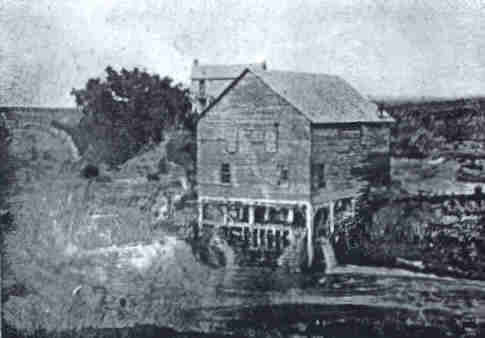
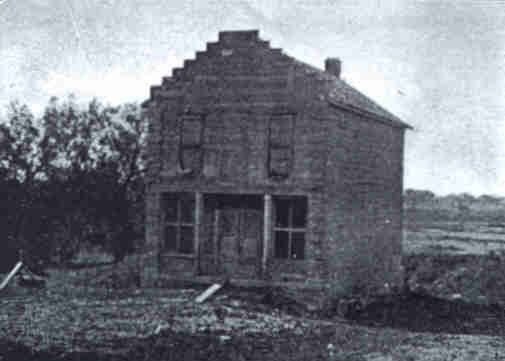
The Sylvan Grove Mill Old Stone Store at Sylvan
BARNARD
The Barnard territory, namely Salt Creek and Scott Townships, was settled by cattlemen about 1868. In 1880 the lands were opened by the government to settlers. Houston & Son, of Concordia, acted as agents. These were the days of sod shanties, dugouts and lonesome bachelors, poor and homesick.
The Barnard Bee gives a history of the town and we quote verbatim from that paper as it is hard to change history, and our write-ups would have to be the same at all events:
"In the spring of 1887, when what is now called the Barnard branch of the Santa Fe was being graded, it was first thought that a town would be started near the center of Salt Creek Township, as that township voted bonds and this one did not. No one thought for a minute that the road would plant a depot just across the line in Scott, a bondless township. So those interested located the probable site for the new town on the land where the late Dan Saunders farm is located, in Salt Creek Township, about three and one-half miles east and one south of the present site of Barnard.
"The Baker Bros. came over from Asherville and started a lumber yard just across the road from the Saunders residence. W.D. Snapp and G.A. King were engaged to build an office for the company. A man named Ross Wilcox was the lumber company's manager.
"But the railroad people had other views, and it became evident that their depot would be located in Scott Township. Immediately two townsites were plotted, one on the west edge of Salt Creek Township, the other just across the township line in Scott Township.
"The town plat in Salt Creek Township was on land belonging to Mrs. Kate Nealeigh; the one in Scott Township on land belonging to A.A. Ballard.
"An interesting rivalry sprung up between the promoters of the two townsites, and the township line dividing them was soon dubbed the neutral strip. The Nealeigh site was facetiously styled 'Slabtown.' In this article we will distinguish between the two places by using the terms now in general use - East Barnard referring to the Nealeigh site, and Barnard, meaning the Ballard Site.
"The first business enterprise secured by either of the two rival sites was the Baker Bros. lumber year, which was moved from the Saunders place to Barnard on its present site.
"The first general store was opened in East Barnard by W.D. Snapp and his son-in-law, Marion Loy. Lew and Lee Morse had been running a store in Old Milo, two and one-half miles northeast of Barnard. Marion Loy and Geo. Snapp bought out the Morse boys at Old Milo when they found there would be no town started on the Saunders place. Five months later (summer of 1887) W.D. Snapp bought out his son George in the store at Old Milo and he and Marion Loy moved the stock of goods to East Barnard where Geo. Saine's house now stands. In a short time W.D. Snapp sold out to Lee Morse, and eventually Mr. Loy retired, which once more left the Morse boys in possession of the business. They failed in business soon after.
"The first residence built in East Barnard was the one now occupied by Geo. Hiserote and family. It was built by Mr. Snapp as a residence for Ross Wilcox, manager of the lumber company.
"In the summer and fall of 1887 East Barnard seemed to hold the edge over its neighbor across the way. Buildings were moved in from Old Milo and some new ones were put up. A man by the name of Gleason opened a general store; a livery stable was also started, operated by John Clark and his father.
"David Metzgar ran first store in Barnard; kept a small stock of flour and feed in building now occupied by J.J. Preo's barber shop. The building then stood about where E.V. Wine's residence is located. Doc Ballard opened up a small stock of groceries in the building now occupied be W.F. Burns and family. Barnard's first postoffice was established in the Ballard store, a man with the unusual name of Smith being the first postmaster.
"Wm. Gill, father of Mell Gill, built the corner store now occupied by C. Coffman. For a while he ran a restaurant and boarded the men who were building the railroad. he later put in a large stock of groceries and general merchandise. This was the first stock of goods of any importance that was put on sale in the new town. Wm. Gill is now located in Holly, Colo., and is still engaged in the same line of business.
"A man named Jim Hoffman built and operated the first hotel, the one now known as the Barnard hotel.
"J.W. Crowl built one of the first residences and still lives in the same building. Mr. Crowl's house and the hotel were built about the same time, and by the same crew of men.
"All this time the railroad graders were hurrying toward Barnard as fast as they could, and on or about the fourth day of December, 1887, the track was completed. On January 15, 1888, the road was turned over to the operating department, and it is presumed that regular train service went into effect that day.
"But the Barnard of to-day is a busy, bustling reality, and once again we invite you to come and visit our little city, look over the beautiful, prolific Salt Creek Valley, and if you know a good thing when you see it you'll camp right here indefinitely."
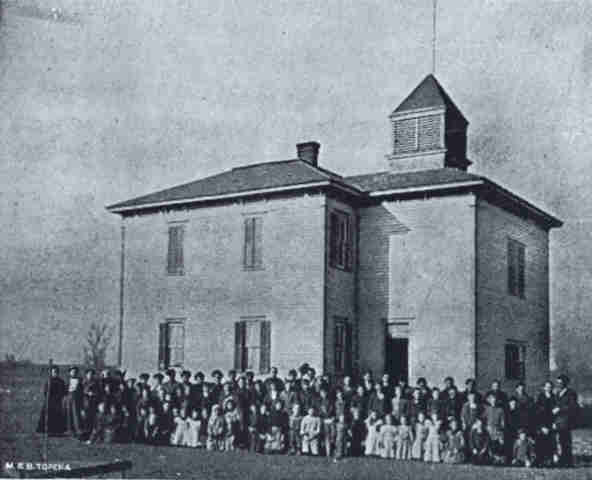
The Barnard School
BEVERLY
Beverly is the successor and sole heir of the promising burg (in embryo) of Colorado, which gracefully gave up the ghost in 1886. The postoffice was moved in this year, and the town plotted. The land belonged to Volany Ball. the railroad came through about this time, and stored began to be built.
D.R. Kernohan, who built the first general merchandise establishment, was succeeded by his son and daughter, who are still in business. A hotel was built and run by Mr. Tussel. The hardware store was owned by Welsh Bros.
C.M. Adamson, who was a doctor and was postmaster at Colorado, kept a drug store in Beverly in the same building with the postoffice.
The first people to settle on or near the site of Beverly was the Colorado boys, in the bend of the river. They have already been mentioned in the county write-up. Anyway, they baffle description, so we will pass on. The next settlers were Smiths and Greens. Mrs. skinner taught the first school which has been mentioned in the "School History." The next school near this place was taught in a dugout by Mattie Seger.
In 1905 the town was organized as a city of the third class. it is protected by a council of five wise men, and a big chief, whose name is T.F. Webb, Sr. Things have always run so smoothly in Beverly that there has never been a dog fight, much less a town row, or a killin'. So it is up to the big chief to furnish enough excitement to keep the people from getting too fat. Accordingly he went out one day and shot a rabbit. The council had the day before passed an ordinance against shooting and the chief was fined $1.00. A little later he went out on the streets and hit a man. This cost him $5.00. His salary is $12.00 per year, but he was public spirited enough to return one-half of it to the treasury in fines.
Some of the early settlers are still here. Dick Clark, alias R.B. Clark, the only one of the Colorado boys still living, Chalzmerz Smith and J.J. Peate, two of Forsythe's scouts; and Waldo Hancock, a protege of the Colorado boys.
We know a little story about Jack Peate, and take this opportunity to tell it. He came to Kansas at the tender age of sixteen. he was with a companion. When they got to the end of the railroad they bought a horse apiece, and started out to ride across the country. in the vicinity of Cawker City, they were surprised and captured by a band of Indians, dog soldiers probably, because Roman Nose was the leader. They were not killed on the spot, as the band was taking a circuitous route to their camp up the Solomon. the captives looked forward with pleasure to the honor of being tortured to death at the camp of this famous Roman Nose. But when they came near the bluff of Wacoanda they ran into a party of buffalo hunters. The captives escaped and went on their way rejoicing. They came down to saline Valley and met some of the Colorado boys chasing some government mules and a beautiful little pony. Now this being Jack Peate's first experience on horseback he did not know how to capture a pony, though his intentions were good enough. So when his horse made a quick, vigorous turn, Mr. Peate went skyward. he landed near the town site of Beverly and has made it his headquarters ever since.
Then there is the Skinner family who were early settlers, and are still one of the most prominent families in the community, and own a large amount of property in and about Beverly. E.T. Skinner is our present legislator. He has shown great interest in preserving historical landmarks.
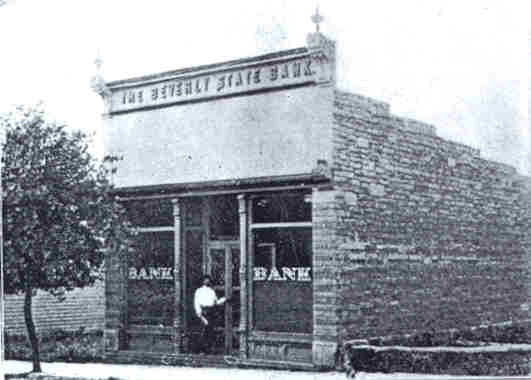
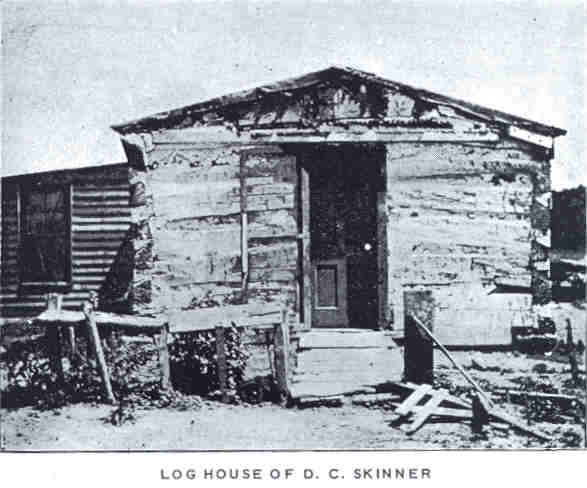
The Beverly State Bank Log House of D.C. Skinner
VESPER
Settlement was begun in Vesper territory in 1869. it is a tradition that a battle occurred in 1868, at Lone Rock three miles south of Vesper between the Indians and some railroad employees, but it is impossible to find anyone who knew the particulars of the matter.
When the settlement was once started the country filled up rapidly, and by 1872 all the government land was taken. Wm. B. Cheney was the first settler. The Middlekauff family was the second, and they came when there was only one house between Lincoln and Vesper. Other settlers were A.W. Lewis, H.S. Steele, Mr. Schofield, Troup Hickey, John Tool, Wm. Baird. Mr. Schofield's place was the objective point of all newcomers upon reaching this part of the country. the first school was taught at H.S. Steele's. The Vesper postoffice was established in 1873 and moved around over the neighborhood for some years. it was first kept at H.S. Steele's farmhouse on section 10, Vesper Township, then in turn at the homes of the following people: Robert Lewis, John Stein, J.P. Harmon, Mrs. Robt. Lewis, whose husband had died in the meantime. While Mrs. Lewis was postmistress the railroad came through and the postoffice moved down near the station. A man by the name of Shoemaker kept the first shoe store. his building was burned later. Mr. Baird, who is a carpenter and architect, built the first wagon ever made in the county in 1873 for Martin Hendrichson. he also built the first windmill for a Mr. Davis. Simon Bough built a store building and kept a stock of merchandise. he sold out to George Elrod, who built an addition to it. Miss Lillie White bought out Elrod. Middlekauff & Gilpin bought out Miss White, and put up the building now occupied by Wick & Jepsen. this firm also built a hardware store. Wick bought out the merchandise part of the business. Thos. Garrity, who had been running a drug store, sold out, built a stone building, bought the stock of hardware. Wick took Mr. Jepsen into partnership and about the same time Porter & Sons put a stock of merchandise on the old Bough building. John Murphy, who bought out Porter & Sons, has gone out of business. Thos. Garrity sold out early in 1908 to Mauris Cromwell. Vesper now has a lumber yard, a blacksmith shop, a hotel, a restaurant, and a meat market, a hardware store and a general store and three flourishing elevators. Pictures of two of them are given below.
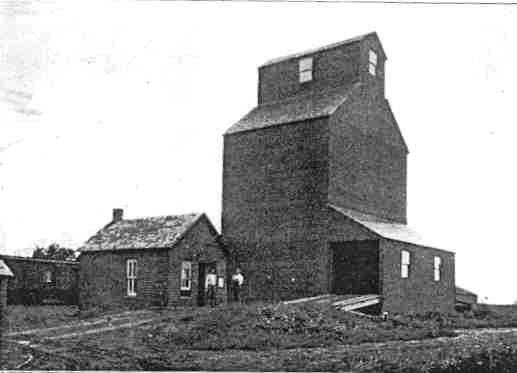
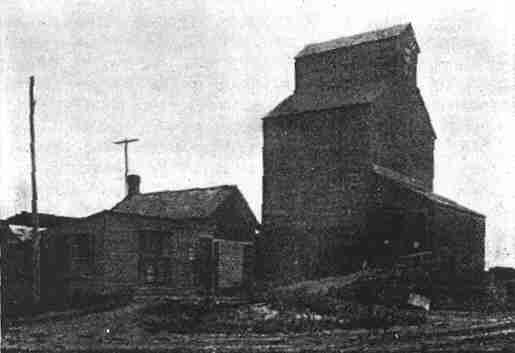
The Farmer's Elevator and S.D. Brumaugh's Elevator
There are two churches, Catholic and Presbyterian. the latter was built by a popular subscription, and is used by all denominations.
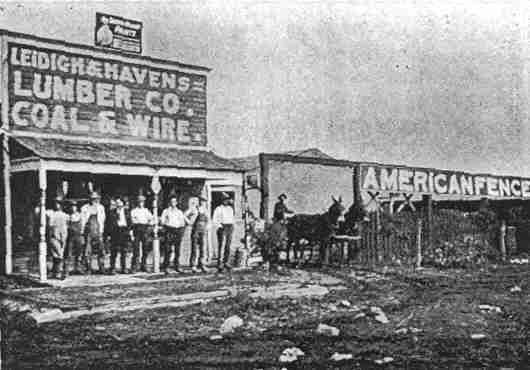
Leidigh & Havens Lumber Yard, Vesper, Kasas
DENMARK
One of the most important communities in Lincoln County history is the settlement of Danes on the Spillman. The first entry in this settlement was made on the southeast quarter of section 23 by Lorenzt Christensen in February, 1869. His brother homesteaded beside him at the same time. Eskild Lawritzen and wife Stine, Otto Peterson, John Maihoff, Mr. and Mrs. Wichel all came during the winter and lived near each other. Of course, they faced many hardships, especially those incident to pioneering in the winter. One instance of these must suffice,
One cold day in February Lorenzt Christiansen, while hueing logs for a dugout, some distance from any house, had the misfortune to cut his foot very severely with the axe. He was obliged to lay in the open without attention all day before help could arrive. His nephew, who was with him, kept up a fire. In the evening he was rescued by John S. Strange.
In the Indian raid which occurred the next May, all the Danes but Peter and Lorenzt Christiansen and their families were killed or captured. These two men fought the Indians all day, and at night made their way with their families, to Schemerhorn's ranch. From there they went to Fort Harker, and later to Junction City, where they remained until January 1, 1871.
When they returned they brought with them from Junction City John Larsen, N. Nielson, A. Rasmussen. the next April the ranks of Danish colonists were further swelled by James Morgeson, Peter Nielson, Peter Anderson, August Hansen, C. Bunk, C. Anderson, Mons Swenson, Olaf Holnberg, Ole Peterson, Peter Anderson, and Nels Peterson. All these people lived long, and were prosperous except Cris Anderson, who was killed in a runaway. Those who still remain at Denmark own beautiful and valuable homes. it tool a long time in those days to subdue the wilderness and make it bloom as a rose and the present generation whose way is made easier in consequence can not be too grateful.
The first school, a log building, was erected in 1875. C.L. Jensen was the first postmaster and storekeeper in the settlement, and his location was next to the present school house site north of the road. Lorenzt Christiansen operated the first blacksmith shop and did work for a very large scope of country.
Later settlers in the Danish colony were H.L. Hansen, L.P. Jensen, Henry Errbo, A.P. Jensen, C. Jensen. H.P. Bernhardt, C. Bernhardt, John Bernhardt, Christian Hendrickson, Mrs. Christiansen, Mattsen, and two Krieser families.
There was one Indian killing which occurred in Denmark neighborhood, which has not yet been recorded in history. Lorenzt Jonhson, which is the American name of Lorenzt Christiansen (his father's name being Chris Johnson), saw some Indians on the Spillman (date uncertain) and noticed that one of them wore a pair of red-topped boots. he recognized the boots as those formerly worn by a friend and shot the Indian wearing them. The body was buried on a promitory near by.